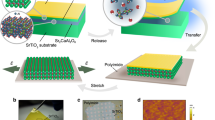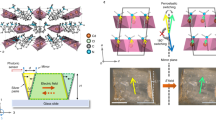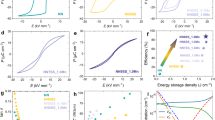Abstract
Ferroelectric materials are used in applications ranging from energy harvesting to high-power electronic transducers1. However, industry-standard ferroelectric materials contain lead, which is toxic and environmentally unfriendly2. The preferred alternative, BaTiO3, is non-toxic and has excellent ferroelectric properties, but its Curie temperature of ∼130 °C is too low to be practical3. Strain has been used to enhance the Curie temperature of BaTiO3 (ref. 4) and SrTiO3 (ref. 5) films, but only for thicknesses of tens of nanometres, which is not thick enough for many device applications. Here, we increase the Curie temperature of micrometre-thick films of BaTiO3 to at least 330 °C, and the tetragonal-to-cubic structural transition temperature to beyond 800 °C, by interspersing stiff, self-assembled vertical columns of Sm2O3 throughout the film thickness. The columns, which are 10 nm in diameter, strain the BaTiO3 matrix by 2.35%, forcing it to maintain its tetragonal structure and resulting in the highest BaTiO3 transition temperatures so far.
This is a preview of subscription content, access via your institution
Access options
Subscribe to this journal
Receive 12 print issues and online access
$259.00 per year
only $21.58 per issue
Buy this article
- Purchase on Springer Link
- Instant access to full article PDF
Prices may be subject to local taxes which are calculated during checkout



Similar content being viewed by others
References
Haertling, G. H. Ferroelectric ceramics: history and technology. J. Am. Ceram. Soc. 82, 797–818 (1999).
Maeder, M. D., Damjanovic, D. & Setter, N. Lead free piezoelectric materials. J. Electroceramics 13, 385–392 (2004).
Takenaka, T. & Nagata, H. Current status and prospects of lead-free piezoelectric ceramics. J. Eur. Ceram. Soc. 25, 2693–2700 (2005).
Choi, K. J. et al. Enhancement of ferroelectricity in strained BaTiO3 thin films. Science 306, 1005–1009 (2004).
Haeni, J. H. et al. Room-temperature ferroelectricity in strained SrTiO3 . Nature 430, 758–761 (2004).
Wang, H. & Ren, M. Synthesis and ferroelectric properties of SrBi2Ta2O9/Bi4Ti3O12/p-Si multilayer thin films by sol–gel. J. Mater. Sci. Mater. Electron. 17, 165–169 (2006).
Qi, X. D., Dho, J., Tomov, R., Blamire, M. G. & MacManus-Driscoll, J. L. Greatly reduced leakage current and conduction mechanism in aliovalent-ion-doped BiFeO3 . Appl. Phys. Lett. 86, 062903 (2005).
Takenaka, T., Nagata, H., Hiruma, Y., Yoshii, Y. & Matumoto, K. Lead-free piezoelectric ceramics based on perovskite structures. J. Electroceram. 19, 259–265 (2007).
Gomah-Pettry, J. R., Saïd, S., Marchet, P. & Mercurio, J. P. Sodium-bismuth titanate based lead-free ferroelectric materials. J. Eur. Ceram. Soc. 24, 1165–1169 (2004).
Wimbush, S. C. et al. Interfacial strain-induced oxygen disorder as the cause of enhanced critical current density in superconducting thin films. Adv. Funct. Mater. 19, 835–841 (2009).
Nagarajan, V. et al. Misfit dislocations in nanoscale ferroelectric heterostructures. Appl. Phys. Lett. 86, 192910 (2005).
Moshnyaga, V. et al. Structural phase transition at the percolation threshold in epitaxial (La0.7Ca0.3MnO3)1–x:(MgO)x nanocomposite films. Nature Mater. 2, 247–252 (2003).
Macmanus-Driscoll, J. L. et al. Strongly enhanced current densities in superconducting coated conductors of YBa2Cu3O7-x+BaZrO3 . Nature Mater. 3, 439–443 (2004).
Aggarwal, S. et al. Spontaneous ordering of oxide nanostructures. Science. 287, 2235–2237 (2000).
Zavaliche, F. et al. Electric field-induced magnetization switching in epitaxial columnar nanostructures. Nano Lett. 5, 1793–1796 (2005).
Fouchet, A. et al. Spontaneous ordering, strain control, and multifunctionality in vertical nancomposite heteroepitaxial films. IEEE Trans. Ultrason. Ferr. 56, 1534–1538 (2009).
MacManus-Driscoll, J. L. et al. Strain control and spontaneous phase ordering in vertical nanocomposite heteroepitaxial thin films. Nature Mater. 7, 314–320 (2008).
Yang, H. et al. Vertical interface effect on the physical properties of self-assembled nanocomposite epitaxial films. Adv. Mater. 21, 3794–3798 (2009).
Munro, R. G. Elastic Moduli Data for Polycrystalline Ceramics 6853 (NISTIR, 2002).
IEEE. Proceedings of the 5th International Symposium on Micro Machine and Human Science 75 (Nagoya, 1994).
MacManus-Driscoll, J. L. Self-assembled heteroepitaxial oxide nanocomposite thin film structures: designing interface-induced functionality in electronic materials. Adv. Funct. Mater. 20, 2035–2045 (2010).
Zheng, H. et al. Multiferroic BaTiO3-CoFe2O4 nanostructures. Science 303, 661–663 (2004).
Schlom, D. G. et al. Strain tuning of ferroelectric thin films. Annu. Rev. Mater. Res. 37, 589–626 (2007).
Megaw, H. D. Origin of ferroelectricity in barium titanate and other perovskite-type crystals. Acta Cryst. 5, 739–749 (1952).
Kuwabara, M., Goda, K. & Oshima, K. Coexistence of normal and diffuse ferroelectric-paraelectric phase transitions in (Pb,La)TiO3 ceramics. Phys. Rev. B. 42, 10012–10015 (1990).
Shintani, Y. & Tada, O. Preparation of thin BaTiO3 films by DC diode sputtering. J. Appl. Phys. 41, 2376–2380 (1970).
Iijima, K., Terashima, T., Yamamoto, K., Hirata, K. & Bando, Y. Preparation of ferroelectric BaTiO3 thin-films by activated reactive evaporation. Appl. Phys. Lett. 56, 527–529 (1990).
Yoneda, Y. et al. Ferroelectric phase-transition in BaTiO3 films. J. Phys. Soc. Jpn 62, 1840–1843 (1993).
Nose, T., Kim, H. T. & Uwe, H. Dielectric property of epitaxial-films of BaTiO3 synthesized by laser-ablation. Jpn J. Appl. Phys. 1 33, 5259–5261 (1994).
Abe, K., Komatsu, S., Yanase, N., Sano, K. & Kawakubo, T. Asymmetric ferroelectricity and anomalous current conduction in heteroepitaxial BaTiO3 films. Jpn. J. Appl. Phys. 36, 5846–5853 (1997).
Jaffe, B., Cook, W. R. Jr & Jaffe, H. Piezoelectric Ceramics (Academic, 1971).
Hong, J. W. & Fang, D. N. Size-dependent ferroelectric behaviours of BaTiO3 nanowires. Appl. Phys. Lett. 92, 012906 (2008).
Megaw, H. D. Crystal structure of barium titanate. Nature 155, 484–485 (1945).
Acknowledgements
The authors are grateful to A. Fouchet for his assistance with preliminary studies. The work was supported by Downing College Cambridge, the European Commission (Marie Curie Excellence Grant ‘NanoFen’, MEXT-CT-2004-014156), European Research Council (ERC) (grant no. ERC-2009-adG 247276), UK Engineering and Physical Sciences Research Council and US National Science Foundation (NSF 07-09831 and ECCS-0708759). We wish to acknowledge the use of the Chemical Database Service at Daresbury and help from the US Department of Energy through the Los Alamos National Laboratory/Laboratory Directed Research and Development programme and the Center for Integrated Nanotechnologies.
Author information
Authors and Affiliations
Contributions
H.W. and Z.B. collected and analysed TEM images. V.G. and S.D. were responsible for SHG data. C.B.E., S.A.T.R., S.H.B. and C.W.B. were responsible for high-temperature XRD measurements. J.Z. advised on direct electrical measurements. M.E.V. and Q.J. discussed the results and commented on the manuscript. S.A.H. prepared films, collected room-temperature XRD data, performed direct electrical measurements and analysed data. S.A.H. and J.L.M. co-wrote the manuscript.
Corresponding author
Ethics declarations
Competing interests
The authors declare no competing financial interests.
Supplementary information
Supplementary information
Supplementary information (PDF 479 kb)
Rights and permissions
About this article
Cite this article
Harrington, S., Zhai, J., Denev, S. et al. Thick lead-free ferroelectric films with high Curie temperatures through nanocomposite-induced strain. Nature Nanotech 6, 491–495 (2011). https://doi.org/10.1038/nnano.2011.98
Received:
Accepted:
Published:
Issue Date:
DOI: https://doi.org/10.1038/nnano.2011.98
This article is cited by
-
Vertical nanoscale strain-induced electronic localization in epitaxial La2/3Sr1/3MnO3 films with ZrO2 nanopillar inclusions
Nano Convergence (2023)
-
The effects of Ti-excess non-stoichiometry on the energy storage performances of BNT-based thin films
Journal of Materials Science: Materials in Electronics (2023)
-
Recent progress in ferroelectric synapses and their applications
Science China Materials (2023)
-
Emerging ferroelectricity and piezoelectric energy harvesting properties in lead-free zinc titanate nanocrystals
Journal of Materials Science (2023)
-
Controlling of lattice strains for crack-free and strong ferroelectric barium titanate films by post-thermal treatment
Scientific Reports (2022)



